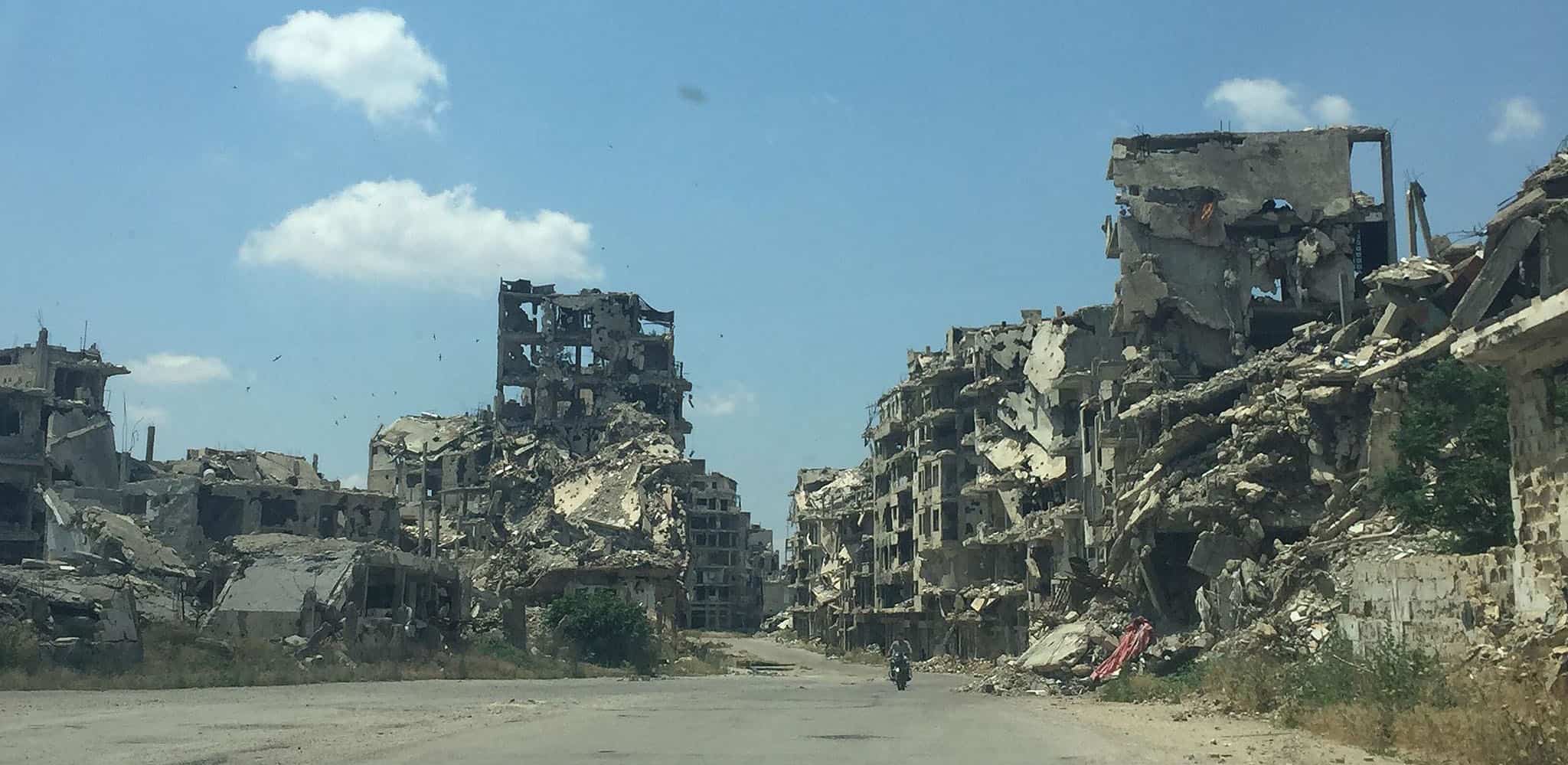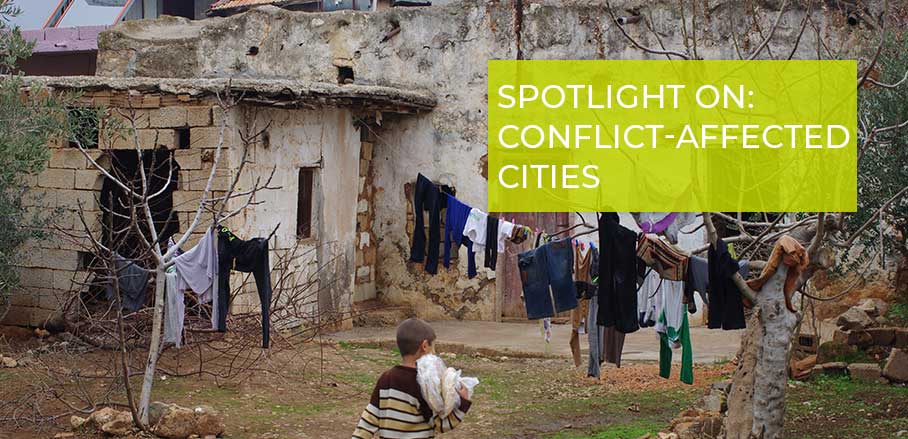My City in Crisis: The Struggle to Reconstruct
As densely populated urban areas like Homs, Raqqa, and Idlib in Syria continue to be the site of years-long armed conflicts, architect Ammar Azzouz argues that cities must not wait for post-conflict reconstruction plans. Rather, amidst destruction, ideas for the cities of tomorrow should be developed.
In 2011, an explosion took place in my neighbourhood in Homs, the third largest city in Syria after Aleppo and Damascus. On that day, three people were killed, including two children and one architect. A few hours later I got to know that it was my own fellow architect friend, Taher Al Sebai.
This was still the early days of the Syrian Revolution, when peaceful demonstrations took place in streets and squares, but also when these spaces started to become the sites of resistance and struggle. Violence began to take place in the city, ripping its social and cultural fabrics, slicing across neighbourhoods, and crushing these peaceful demonstrations.
For almost nine years now, my city has been radically reshaped as its different parts such as Baba Amr and the Old City of Homs have been partially besieged multiple times. According to a report by UN Habitat, 50 per cent of the city’s neighbourhoods are heavily damaged whilst another 22 per cent are partially damaged. Homs, the city that I used to know, has changed forever.
Cities as Battlefields
Wars have changed in their nature. Violence and conflict take place in urban and dense areas, making cities their battlefield. In these wars, communities find themselves at the heart of these contested and divided cities. Mass destruction of their architectures erases the memory and presence of certain communities, causing them deep suffering.
Cities as Gaza, Misrata, Mosul, Aleppo, and Raqqa have become targets of warfare. Conflicts are not only destroying historical and cultural artefacts, but also places and spaces of everyday urban life such as homes, markets, bakeries, schools, and hospitals. Cities have become the sites of contestation.

Destruction of Homs © Majd Murad
Urban Planning for the Future
Urban planning and architecture play crucial roles in times of conflict, as they tend to be used by those in power to divide communities, to punish people through destruction, and to re-engineer social and spatial injustices in cities. But urban planning and architecture will also be the platforms to build the future of these war-torn cities and their communities. This should start at the time of crises.
Long-term conflicts have made it urgent for architects, urban planners, and engineers to rethink their traditional roles and responsibilities. In Syria, where conflict has been wrecking the country for years since 2011, professionals in the built environment can no longer wait for ‘post-war’ resolution plans, or ‘post-conflict’ reconstruction visions. Rather, efforts are made at different levels to preserve what remains of cities, to respond to the current mass destructions and displacement, and to imagine the future of Syria.
During the last three years, I interviewed over 100 Syrians who are working on the ground to understand how conflict has impacted their profession. What is remarkable is that amidst the extreme situations in contested cities, people show high levels of resilience and resistance. Some architects and engineers are assessing and mapping the damage of buildings, others are working with local and/or international NGOs to provide shelter to internally displaced communities. New questions and new missions have emerged, pushing the architecture and engineering professions to the edge. Architecture has been brought closer to responding to humanitarian catastrophe in Syria.
Rebuild – But for Whom?
Today, despite the ongoing conflict and the changing dynamics of war in different parts of Syria, visions, debates, and proposals on the future reconstruction of Syria have emerged. But how to rebuild ruined cities in Syria such as Aleppo, Homs, Raqqa, and Idlib? For whom? And by whom? Whose voices will be heard in shaping the future of Syria?
Many of the emerging debates on reconstruction are synonymous with new waves of destruction in the name of modernisation ad reconstruction of cities. There are proposals to leave destroyed cities and build brand-new cities outside the former ones. There are plans to demolish ruined neighbourhoods and replace them with copies of tower blocks. But these do not reflect the identity and the character of cities and would benefit only the few economic elites and warlords. Many of these plans are proposed without consultation with local communities nor are they addressing their needs, dreams, hopes, and aspirations.
Past reconstruction efforts of cities in different geographies have shown that unjust and unsustainable reconstruction projects can create increased social and spatial injustices which divide communities further instead of bringing them back together. We already have the Sustainable Development Goals as a collective framework for our cities, so how could these goals benefit the future cities of Syria and how could voices from all levels of society be heard in the imaginations of a future Syria?
Rethinking Responsibilities and Opportunities
With the lack of sustained access to economic opportunities, millions of people have been pushed into unemployment and poverty. This includes architects and engineers who explain to me how keen they are on using their skills – not only to develop their careers but also to shape the future of their ruined homeland. Many architects I spoke with have already shifted towards other jobs instead of being part of an architectural community that could help to heal cities through their professions.
As professionals in the built environment who are working outside Syria, we must rethink our roles and responsibilities. There are opportunities to create cutting-edge research opportunities with scholars at risk in Syria, to establish innovative initiatives enabling co-working with communities in war zones, to transfer digital tools, technologies, processes that are shaping our built environment.
Translation of materials and educational systems to Arabic would be of extreme value. Remote recruitment and online mentorship programmes would bring hope to the unemployed. Architects, engineers, academics, and policy-makers should collaborate to implement these ideas so that resources, knowledge, economic opportunities, and training materials can be offered to communities in contested cities within fragile states. This would not only benefit cities in Syria but could be transformed to other sites of contestation such as Iraq, Yemen, Libya, and Palestine.
So, how will the Syrian city of tomorrow look like? How much of the city’s memory could be brought back through the built environment – to foster togetherness amongst fragile and contested communities, to help impactedcommunities to recover from the horrors of war? Urban planning and architecture can help us to heal – if they are built on inclusivity, diversity, and justice, in a place where cities are built for people and not for profit.
- My City in Crisis: The Struggle to Reconstruct - 10. December 2019
